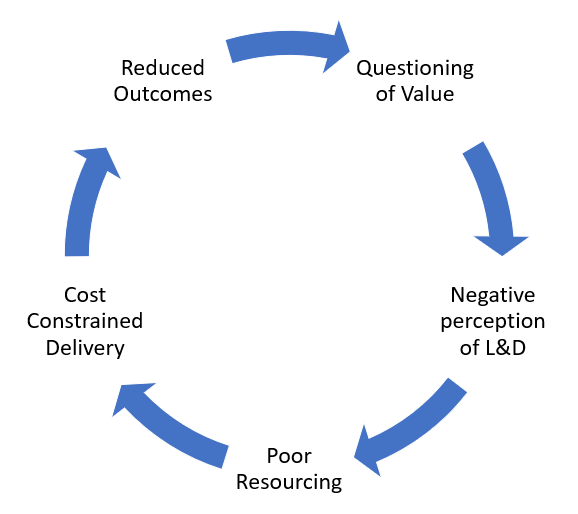A recent three-nation survey on Learning Transfer conducted by a consortium led by the University of Sussex made for some salutary reading.
The survey looked at the US, the UK and Australia and found that Australian employers were the least likely to insist on staff undertaking learning. Australians were much more likely to report “regulatory compliance” as the primary goal of training and conversely, while one in eight American respondents listed the primary goal as to “provide engaging, relevant and well received learning opportunities”, not a single Australian did.
As for outcomes, while most US respondents and almost half of UK respondents viewed training investments as “generally beneficial”, only 28% of Australians felt the same way. Most alarming of all, well over a third can’t say whether their job performance is improved through the training offered to them at all and are left wondering why they are made to do it in the first place.
Australians also reported that training is delivered to mainly comply with external regulations rather than to improve their performance. Even management question the value to the point that Australian management is the least likely to back training through policy.
Given those findings, it’s little surprise that Australians are far less enamoured of their trainers. While L&D staff in the UK and US are trusted to deliver effective learning experiences by 72% and 60% respectively, a mere 38% of Australians have that view.
If that does not point to a trust problem, I don’t know what does…
The benefits of building that trust are manifest; on average employers outside Australia were prepared to devote $1,930 per staff member last year in training compared to $735 in Australia. With a third of the resources available to deliver outcomes, it’s small wonder L&D are not able to build the trust they can elsewhere. It’s a catch 22 situation.

The good news is that the same survey tells us that this is much less the case elsewhere and by implication that it does not have to be that way. But the job is ours; noone else is going to break the cycle so the task falls to us trainers.
We must work to change the perception of our work before we’ll get more resources with which to do it.
Impossible? – No. Just ask the British and Americans…
Regardless of where on the cycle you’re standing the exit ramp is trust.
Fortunately, building trust doesn’t have to involve dollars. Time and effort maybe, but not budget initially. It starts with introspection; for trainees and management to better trust L&D to deliver real outcomes for them personally, L&D needs to be prepared to question what it does now:
- Does your training prioritise the needs of the trainee, or the needs of external regulators?
- Are the courses you deliver crafted to maximise results or are they the least expensive/most convenient third party offerings?
- How often do you measure the knowledge gaps in your organisation?
- Does the pace of change to your courses match the pace of change in your industry?
- Do you undertake effective measurement of outcomes and continually improve the material in response?
- Is the delivery mode driven by knowledge of the most effective format for the situation or is it driven by what is possible?
- In the shoes of your trainee, how eagerly would you participate and why?
- When was the last time you asked trainees and management for their goals and in particular for their training priorities?
I do get it – you have always wished you could do more of this but it’s not possible with the resources you have. That’s not a reason not to ask these questions. If others are expected to undergo a needs analysis, why not L&D? Am I right?
Trust me, solutions will emerge; for example:
If your original objectives no longer align with management’s priorities but recreating everything is absurd. Look through it to find what can be adjusted and drop anything that no longer is serving the organisation’s objectives. Use the time you’d otherwise spend delivering the rest to survey people at all levels for their goals, identify the single most important unmet need and develop one item only that addresses it. Build trust by involving those who called for it to the extent you possibly can and in so doing demonstrate your commitment to ensuring you fully meet their needs.
If your material’s badly dated but you don’t have the resources to update it properly, why not learn to make video on a shoestring so you can interview some of your awesome in-house experts and turn it into microlearning? Whenever you deliver it, the recognition upon which it’s based will build trust.
If you are delivering primarily compliance training, it’s natural for people to see your work as an extension of a regulator, rather than aimed at maximising their potential. No matter how vital that compliance training is, it is aimed at addressing problems you hope will never arise. Inevitably it is perceived (wrongly) as pointless unless it’s carefully contextualised by building more practical material alongside it. If you don’t have the resources to offer more structured training in areas that your team do value offer unstructured options instead.
If your training is dry and boring but you don’t have the ability to redevelop it the way you’d like, read this article on crowd sourcing your engagement. Build on that over time until one day the case for it is so solid, the business case for a full Learning Experience Platform is self evident.
Over to you….
